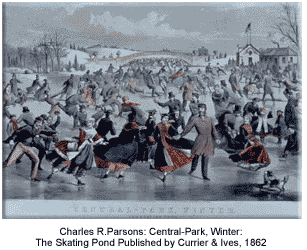 During the 1840s, Nathaniel Currier produced many memorable and nostalgic lithographic prints of everyday life, notably the heart-warming winter scenes of the northeastern U.S. Nathaniel hired his 21-year-old brother Charles, in 1841, taught him lithography, and in turn Charles developed a new lithographic crayon that he patented and called the "Crayola."
In 1852, Charles arranged a meeting between his brother and James Merritt Ives. As a native New Yorker, Ives was a self-taught artist and professional bookkeeper.
From the beginning, Ives set out to improve the way Currier kept his books, by reorganizing the firm's immensely large collection of art and the way sales were processed. With his artistic, as well as business abilities, Ives also increased production throughout the company.
Due to his business acumen, Ives was made general manager and a full partner of the firm in 1857. The company was renamed "Currier and Ives," and their business began to be described as “publishers of cheap and popular pictures.”
Between 1835 and 1907, the company produced more than 7,500 different titles and one million prints. During the Civil War, the demand for Currier and Ives' lithographs was so high they developed colored stencils to speed up the production process.
Buried in the Greenwood Cemetery in Brooklyn, New York, Currier died first in 1888 and then Ives in 1895.
During the 1840s, Nathaniel Currier produced many memorable and nostalgic lithographic prints of everyday life, notably the heart-warming winter scenes of the northeastern U.S. Nathaniel hired his 21-year-old brother Charles, in 1841, taught him lithography, and in turn Charles developed a new lithographic crayon that he patented and called the "Crayola."
In 1852, Charles arranged a meeting between his brother and James Merritt Ives. As a native New Yorker, Ives was a self-taught artist and professional bookkeeper.
From the beginning, Ives set out to improve the way Currier kept his books, by reorganizing the firm's immensely large collection of art and the way sales were processed. With his artistic, as well as business abilities, Ives also increased production throughout the company.
Due to his business acumen, Ives was made general manager and a full partner of the firm in 1857. The company was renamed "Currier and Ives," and their business began to be described as “publishers of cheap and popular pictures.”
Between 1835 and 1907, the company produced more than 7,500 different titles and one million prints. During the Civil War, the demand for Currier and Ives' lithographs was so high they developed colored stencils to speed up the production process.
Buried in the Greenwood Cemetery in Brooklyn, New York, Currier died first in 1888 and then Ives in 1895.